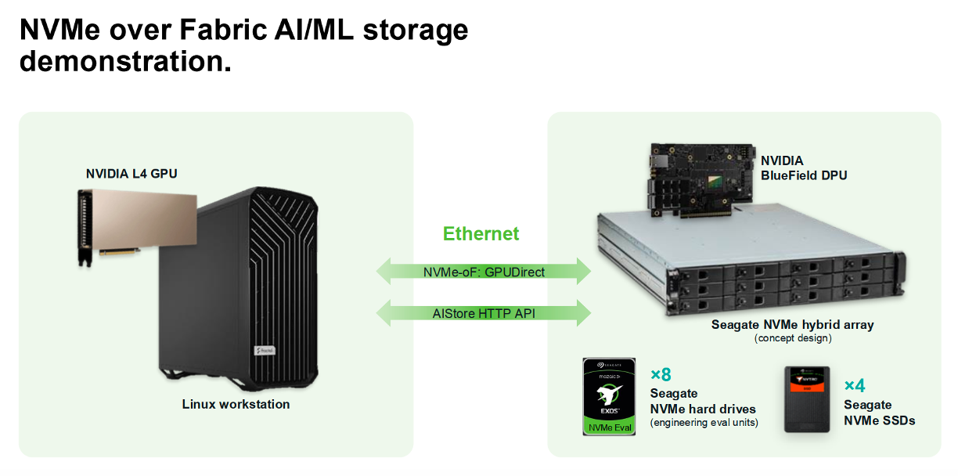Drawing of Seagate GTC NVMe HDD demonstration
During the 2025 Nvidia GTC Seagate was showing NVMe prototype hard disk drives in conjunction with Nvidia. While we shouldn’t expect that NVMe HDDs will dominate the market right away, I think there are reasons to think their time is coming soon! Let’s take a look at the history of NVMe HDDs, the 2025 demonstration and discuss why NVMe makes sense as an HDD storage interface that will enable future HDD innovation.
Seagate, WDC, Microsoft, Dell and HP spoke about NVMe HDD and even tape drives and Seagate at an Open Compute Project Summit back in 2020. In a late 2021 a Seagate NVMe HDD demonstration at the 2021 OCP Summit included a customized HDD enclosure with twelve 3.5-inch HDDs using a proprietary controller supporting SAS, SATA and NVMe natively without the need for a bridge.
Moving to a common interface for all storage could reduce storage system complexity can help enable dynamic composable storage for data centers, improve overall HDD performance, reduce overall storage system costs and could be an important element in reducing HDD power consumption.
The Seagate demonstration at the 2025 GTC combined four 4TB NVMe SSD for cache with eight 32TB HDDs for data supplying 256TB total storage with 3GB/s data rates. This provided a performance equivalent to four 64TB SSDs at 1/6th the cost. It combined Nvidia’s BlueField DPU and Nvidia AIStore software to show how a single storage interface using NVMe can address the requirements of AI environments at lower cost than for all SSD systems. Nvidia’s AIStorage is part of the company’s reference design for the future.
The image below, from a Seagate presentation shows a high-capacity enterprise HDD with an SSD cache both functioning over a PCIe bus to the DPU and a special NIC supporting remote direct memory access using NVMe-oF and AIStorage object storage with optional GPUDirect capability for the HDD data.
Seagate schematic for the 2025 GTC NVMe HDD demonstration
Replacing traditional SAS or SATA HDD interfaces with native NVMe eliminates the need for additional hardware and overhead from host bus adapters, protocol bridges and SAS infrastructure.
In my conversation after the 2025 GTC with Tom Prohofsky and Mohamad El-Batal from Seagate Technology they told me that the 2025 GTC NVMe HDD demonstration was with HAMR-based Mozaic HDDs with 7nm silicon. As shown below, going to a full NVMe HDD future would lead to HDD access without a PCIe switch, further removing storage system overhead and complexity.
NVMe simplies HDD storage networking
Being able to create hardware automation with dedicated silicon used for data movement can use less power and improve communication efficiency using NVMe HDDs. This can be a big gain when lots of HDDs are being used.
So, are NVMe native HDDs going to go into production soon? I think that there are reasons why this might happen. First, HDDs are being made with higher capacity, up to 36TB today but with more than 50TB per HDD in the next couple of years.
Higher capacity is likely to drive the need for dual actuators in these big drives to improve the performance, by about 2 times, to enable lower HDD rebuild times, among other advantages. Faster HDD performance could be better used in an NVMe architecture that is built around higher performance storage.
In addition, SSDs are moving away from SAS and SATA interfaces to NVMe. SATA, in particular, is not being developed further for storage systems. This will decrease the demand and thus increase the cost of new SAS or SATA hardware, making NVMe interfaces for HDDs based upon the widely used PCIe bus more attractive.
I was also told by Seagate that major HDD customers, including cloud data centers are evaluating the use of NVMe HDDs in their data centers. It is also possible that Seagate may introduce NVMe HDDs in their own storage system offerings which could help stimulate the market.
I think that NVMe HDDs will show up in some initial storage systems by the end of 2026, likely in conjunction with the introduction of dual actuator HDDs and that NVMe HDDs will dominate in enterprise and data center HDD storage by 2028.
